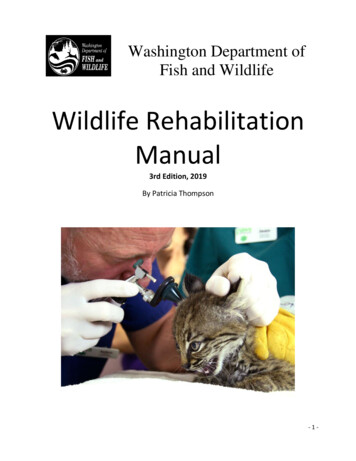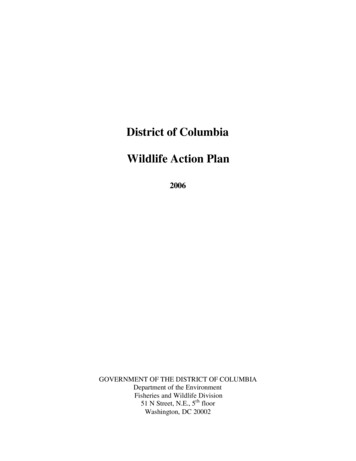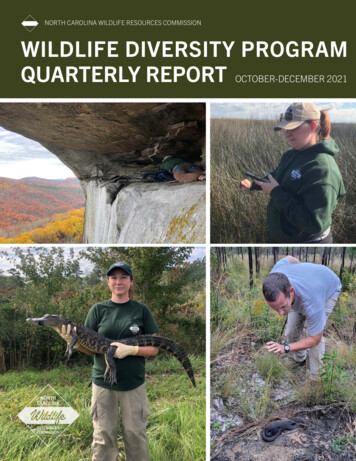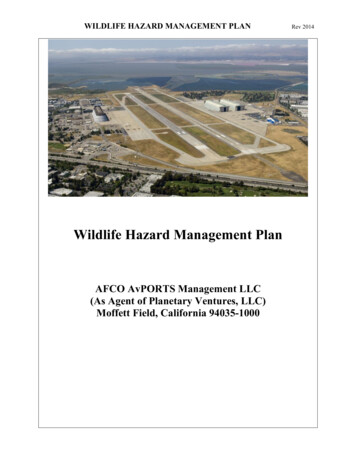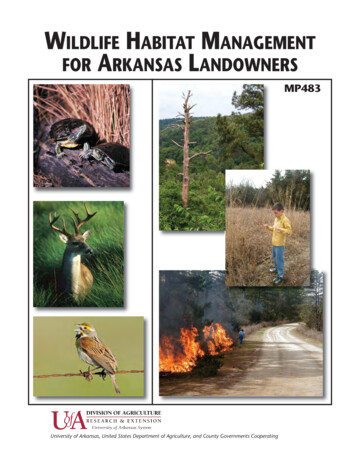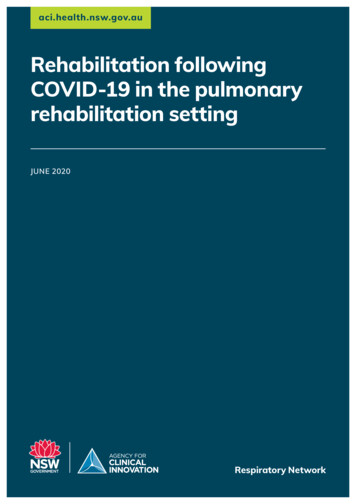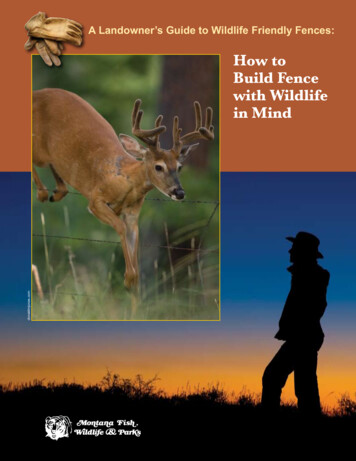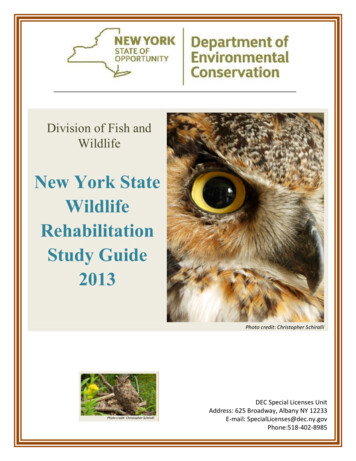
Transcription
Division of Fish andWildlifeNew York StateWildlifeRehabilitationStudy Guide2013Photo credit: Christopher SchiralliPhoto credit: Christopher SchiralliDEC Special Licenses UnitAddress: 625 Broadway, Albany NY 12233E-mail: SpecialLicenses@dec.ny.govPhone:518-402-8985
AcknowledgementsThe 2013 revision of the NYSDEC Wildlife Rehabilitation Study Guide and Wildlife RehabilitationPractice Examination represent the best efforts of people who care about wildlife. These booklets wereproduced by wildlife professionals: veterinarians, biologists, and rehabilitators. These documents shouldnot be considered the end point of a project but rather the beginning of a cooperative process amongwildlife professionals for the benefit of wildlife in New York State.The New York State Department of Environmental Conservation, Division of Fish and WildlifeResources would like to say thank you to all the individuals and organizations that contributed to thisstudy guide and all previous versions.THE NEW YORK STATE WILDLIFE REHABILITATION COUNCILAND BOARD OF DIRECTORSKelly MartinBarbara HollandsCheryl HoopleAmy FreimanJean AldenLainie AngelBarb ColeMaggie CiarciaVirginia FratiSue HeighlingBeverly JonesEllen KalishTerri MurphyVeronica SerwackiMatt ZymanekTHE NATIONAL WILDLIFE REHABILITATORS ASSOCIATIONCORNELL UNIVERSITY C OLLEGE OF VETERINARY MEDICINEElizabeth Bunting, VMDJohn FiegerKailey BanksNicholas HollingsheadNYSDEC SPECIAL LICENSES UNITPaul StringerWildlife Rehabilitation Program CoordinatorNYSDEC WILDLIFE REHABILITATION STUDY GUIDE 20132
Table of ContentsACKNOWLEDGEMENTS. 2I.INTRODUCTION TO THE STUDY GUIDE AND PRACTICE EXAMINATION . 5What is the Study Guide? . 5How to use the Study Guide . 5What is the Practice Examination?. 5How to use the Practice Examination . 5How to prepare for the NYS Wildlife Rehabilitation Examination . 6II.INTRODUCTION TO WILDLIFE REHABILITATION: PURPOSE AND PHILOSOPHY . 7Definition of wildlife rehabilitation . 7What licenses are required to be a wildlife rehabilitator? . 7Obtaining a wildlife rehabilitator license . 7Additional permits for education and research, and rabies vector species . 8Communicating with licensed wildlife rehabilitators in New York State . 8What is a “qualified beginning rehabilitator?” . 9III.WHY PEOPLE BECOME WILDLIFE REHABILITATORS . 10A licensed wildlife rehabilitator’s role in the community . 10A licensed wildlife rehabilitator's responsibilities in the community . 11Realities of being a licensed wildlife rehabilitator . 12Cultivating a relationship with a veterinarian. 14Education and wildlife rehabilitation . 14Who to call when a problem arises . 15IV.ISSUES OF IMPORTANCE TO LICENSED WILDLIFE REHABILITATORS . 17Identification of animal species . 17Individuals vs. populations . 17Deciding what is important. 18Preventing disease transmission . 18Release . 19What if the animal cannot be released? . 20V.HUSBANDRY . 22Housing . 22Disinfection . 23Nutrition . 26Medical math . 27Stress . 28Triage and first aid . 28Fluid therapy math . 30Subcutaneous fluid administration . 33Spring "orphans" – birds . 35Spring “orphans” – mammals . 37Taming and imprinting . 37NYSDEC WILDLIFE REHABILITATION STUDY GUIDE 20133
GLOSSARY . 39APPENDIX I. NYSDEC REGIONAL WILDLIFE OFFICE LOCATIONS . 43APPENDIX II. RELEVANT SECTIONS OF ENVIRONMENTAL CONSERVATION STATUTES & REGULATIONS. 44Wildlife Rehabilitation Information - 6 NYCRR Part 184. Wildlife Rehabilitation Regulations. 44Environmental Conservation Law 11-0515 : Licenses to collect, possess or sell forpropagation, scientific or exhibition purposes. . 46APPENDIX III. LICENSE CONDITIONS . 47Class I Wildlife Rehabilitation License Conditions . 47General Conditions – Apply to ALL Authorized Licenses . 50Notification of other licensee obligations . 51APPENDIX IV. PERTINENT FEDERAL LAWS AND AGENCIES . 53Laws are administered by the United States Department of the Interior Fish & WildlifeService (USFWS). . 53Law administered by the Department of Commerce National Oceanographic andAtmospheric Administration (NOAA) National Marine Fisheries Service (NMFS) . 54Regulations administered by the Department of Agriculture Animal and Plant HealthInspection Service (USDA –APHIS) . 54APPENDIX V. ORGANIZATIONS FOR REHABILITATORS . 55State Organization . 55National Organizations. 55APPENDIX VII. WEBSITES AND REFERENCES. 56Websites . 56Useful books and guides for rehabilitators. 56Useful field guides for animal identification . 57NYSDEC WILDLIFE REHABILITATION STUDY GUIDE 20134
I. Introduction to the Study Guide and Practice ExaminationYou have received this booklet because you have expressed an interest in becoming licensed torehabilitate wild animals in the State of New York. The factual and philosophical information in thisbooklet will help you to understand the nature of wildlife rehabilitation, and will help you decidewhether or not you really wish to become involved in this activity.It is important to remember that the information in this booklet is just the barest introduction to wildliferehabilitation. Understanding and learning these concepts will help you acquire your license, but theinformation contained in these booklets should be just the beginning of your learning. A goodrehabilitator continues to develop his/her skills. It is by reading some of these references, going toconferences, and networking with other rehabilitators that you will improve.What is the Study Guide?The Study Guide will serve as your introduction to the field of wildlife rehabilitation. It contains a greatdeal of information about the nature of wildlife rehabilitation in an easy to read format. The Study Guidealso tells you how wildlife rehabilitation is regulated by the State of New York. The accompanyingPractice Examination contains nearly 500 questions with answers and explanations for you to study.How to use the Study GuideFirst read the Study Guide with care. Some of the examination questions are taken directly from thematerial in the Study Guide. Secondly, it is to your advantage to obtain a good rehabilitation manual tohelp answer questions that may not be directly covered in the Study Guide.You should spend some time seriously considering some of the difficult biological and philosophicalissues presented in the Study Guide. It is equally important that prospective rehabilitators spend sometime working with and learning from people who are already licensed to rehabilitate wildlife. Each year,the New York State Department of Environmental Conservation (NYSDEC) produces a list of activelicensed wildlife rehabilitators, which is available to all wildlife rehabilitators.What is the Practice Examination?The examination to become a licensed wildlife rehabilitator in New York consists of approximately 100written questions. You must achieve a score of eighty percent (80%) or higher to pass this examination.The questions are derived from the material covered in the Practice Examination. This will help youunderstand the reasoning followed by licensed wildlife rehabilitators and NYSDEC staff.How to use the Practice ExaminationBy reading the questions and studying the answers you will learn a great deal of specific informationabout the biology of wild animals and the nature of wildlife rehabilitation. Do not attempt to memorizethe examination. Rather, you should use it as a guide to your thinking. Always ask yourself the “why”questions--why is answer “c” better than “a”? The correct answer to the question is the basic knowledgewhich one can build upon.NYSDEC WILDLIFE REHABILITATION STUDY GUIDE 20135
How to prepare for the NYS Wildlife Rehabilitation ExaminationThe examination contains a great deal of specialized information. It will be difficult to do well on itwithout study and advanced preparation.The Study Guide and Practice Examination should be the starting point in your study. The Principles ofWildlife Rehabilitation manual published by the National Wildlife Rehabilitation Association (NWRA)(Appendix VII), or another similar reference, will also be a valuable asset. Purchase some of the morecommon field guides for identification of native animals, and look up each of the species mentioned inthe Study Guide to begin learning about our native wildlife.We have tried to make the examination questions as clear and unambiguous as possible. Each questionhas only one answer that will be considered correct. If you disagree with the answer given, or havequestions about the material, please contact the NYSDEC Wildlife Rehabilitation Program Coordinatorin Albany with your comments.The best way to become familiar with the realities of wildlife rehabilitation is to spend time withlicensed practicing rehabilitators. Your regional NYSDEC office (Appendix I) can assist you in findinglicensed rehabilitators in your area. A list of wildlife rehabilitators is available athttps://www.dec.ny.gov/cfmx/extapps/sls searches/index.cfm?p live rehabVolunteering or becoming an assistant wildlife rehabilitator is highly recommended and will help youdecide if you want to dedicate the time, money and effort required to be a good rehabilitator. Askquestions about the best facilities, look at the kinds of reference books used by licensed wildliferehabilitators, find out how they have located cooperating veterinarians, and to whom they go whenquestions arise. An apprenticeship with a federally licensed avian wildlife rehabilitator is, in fact, arequirement for issuance of a Federal permit to work with many species of birds.You can also become a member of a state wildlife rehabilitation organization, such as the New YorkState Wildlife Rehabilitation Council (NYSWRC), and one or both national organizations: NWRA andInternational Wildlife Rehabilitation Council. See Appendix V for more information about theseorganizations. These groups publish newsletters that will serve as another invaluable educationalresource.Whenever possible, you should attend a state or national conference for wildlife rehabilitators. Trainingoffered at these conferences may become mandatory in the future and adds significantly to your abilityto perform rehabilitation at its highest level.NYSDEC WILDLIFE REHABILITATION STUDY GUIDE 20136
II. Introduction to wildlife rehabilitation: purpose andphilosophyDefinition of wildlife rehabilitationWildlife rehabilitation is the practice of legally caring for sick, injured, orphaned or displaced wildlife inorder to release a physically healthy and psychologically sound animal back into the wild. This caninvolve rescuing, raising, and arranging for veterinary medical care. Successful rehabilitation results inan animal fully capable of functioning in the wild. This includes recognizing their natural diet, obtainingappropriate foods, interacting with and selecting mates from their own species, and demonstrating anormal fear of potential dangers (cats, dogs, people, cars, etc.).What licenses are required to be a wildlife rehabilitator?A licensed wildlife rehabilitator is a person who carries out the aforementioned activities. A special statelicense is required in virtually all areas of the United States to legally conduct wildlife rehabilitationactivities. Permits from these federal agencies are also required to rehabilitate the following species:US Fish and Wildlife ServiceMigratory birds and all threatened and endangered species, such as bald and golden permit/contact-usNational Oceanic and Atmospheric AdministrationMarine mammalshttp://www.nmfs.noaa.gov/Obtaining a wildlife rehabilitator licenseTo get a license as a wildlife rehabilitator in New York, you must meet the following qualifications:1. Be over the age of 16 years, a resident of New York and of good character and reputation in thecommunity as judged by two character references written by persons not related to you or eachother;2. Not have been convicted of or pleaded guilty to a violation or misdemeanor under theEnvironmental Conservation Law or settled and compromised a civil liability, nor have beenconvicted of any misdemeanor or felony within the previous 3 (three) years;3. Receive a grade of 80% (eighty percent) or higher on a written examination administered by thedepartment and designed to test your knowledge in the field of wildlife rehabilitation; and4. Be interviewed by a regional department employee responsible for the wildlife rehabilitationprogram to assess your proficiency in wildlife rehabilitation.NYSDEC WILDLIFE REHABILITATION STUDY GUIDE 20137
If you feel that you are qualified, the first step in the licensing process is to complete the WildlifeRehabilitator License Exam Application (http://www.dec.ny.gov/permits/25027.html) to registerfor the exam. Return the form to:NYSDECDivision of Fish, Wildlife and Marine ResourcesSpecialLicenses@dec.ny.govSpecial Licenses Unit625 BroadwayAlbany, NY 12233-4752If you have questions, please call the Wildlife Rehabilitation Program Coordinator at (518) 402-8985.The Special Licenses Unit will receive and process your application. They will notify you of the dateand location of your examination approximately one month before the scheduled exam date.Additional permits for education and research, and rabies vector speciesRemember that a Wildlife Rehabilitator License does not allow you to keep animals long-term foreducational or scientific purposes. Additional special licenses are needed for these activities.Additional permit requirements must be met to hold educational animals, body parts, nests, eggs and/ orto present programs using live animals.Rehabilitators that are licensed by NYSDEC are not permitted to handle or possess rabies vector species(RVS) without an additional WRL-RVS license. This includes transportation of these species to alicensed rehabilitator. The WRL-RVS license requirements include attending a special training courseoffered at the New York State Wildlife Rehabilitation Council's annual seminar, followed by meeting anumber of other requirements by several state agencies. Additional requirements include a workingrelationship with a cooperating veterinarian, pre-exposure vaccinations, construction of special housingin an area separate from other animals with posted, double wired and double door locked caging, andinspections from the State officials. Forms are available at , rabies vector species in NY include raccoons, skunks and bats.Communicating with licensed wildlife rehabilitators in New York StateThe New York State Wildlife Rehabilitation Council (https://www.nyswrc.org) and other licensedwildlife rehabilitators in the state have developed an informal statewide communication network toenhance education and cooperation between rehabilitators. This network gives you the ability to contactother rehabilitators by telephone or email in order to obtain information and advice on wildlife concerns.If an animal needs specialized care or facilities, the network can help you move animals quickly (unlessother regulations are applicable) into appropriate care.The important working relationship between rehabilitators and the NYSDEC is also part of the networkof wildlife care. The NYSDEC provides timely and relevant information on wildlife issues, overseesyour licenses, and directs the public to licensed wildlife rehabilitators when necessary.NYSDEC WILDLIFE REHABILITATION STUDY GUIDE 20138
What is a “qualified beginning rehabilitator?”A person who has passed the NYSDEC licensing examination in New York State, and has completedany other requirements mandated by the state, is a qualified beginning rehabilitator with a WRL 1license. Possession of a state issued rehabilitation license allows you to accept native mammals,(excluding the rabies vector species which requires additional training and licensing), reptiles andunregulated bird species (such as pigeons, European starlings, house sparrows) and some regulatedgame birds (turkey, pheasant, grouse). An additional permit issued by the U.S. Fish and Wildlife Serviceis required to rehabilitate songbirds, birds of prey and other federally regulated ies.php).Every newly licensed wildlife rehabilitator must keep in mind that there is a vast amount of continuouslearning. The welfare of the animals you take in is dependent on an awareness of your limitations. Youwill gain experience as you identify, handle and care for wildlife, but much of your continuingeducation must come from reading, attending meetings and conferences, and learning from moreexperienced rehabilitators. Your early years as a licensed wildlife rehabilitator will be critical in learninghow to most effectively help distressed wildlife.NYSDEC WILDLIFE REHABILITATION STUDY GUIDE 20139
III. Why people become wildlife rehabilitatorsA licensed wildlife rehabilitator’s role in the community1. Provide care for distressed wildlifeLicensed wildlife rehabilitators exist because of the public's need to find qualified care for wildlife indistress. It is the job of the licensed wildlife rehabilitator to coordinate the medical and nursing care forailing or orphaned wild animals. Possession of a license to rehabilitate wildlife does not make thepossessor a veterinarian, wildlife biologist, law enforcement agent, or a nuisance animal control officer.Therefore, it is important to have sound relationships with other professionals to avoid or alleviate manyof the problems that occur when people and wildlife come into conflict.Wildlife biologists working for the NYSDEC and other State and Federal agencies are responsible formaintaining healthy wildlife populations and preserving the natural habitats critical to their survival. TheDepartment of Health is responsible for control of zoonotic diseases (those diseases that may spreadfrom wildlife to people). The Department of Agriculture and Market's staff members concern themselveswith the positive and negative effects that wild animal populations may have on the state's agriculturalresources. Good rehabilitation practices must understand and balance the concerns of these agencieswith those of the individual wild animal.2. Educate the publicAs a licensed wildlife rehabilitator you will serve as an “Ambassador for Wildlife.” In many cases, youwill be the first contact the public has with the professional wildlife community. What you say to thepublic, both on the phone and in person, may be crucial to the health and safety of that person. Don'ttake this responsibility lightly! In general the public is often very caring, but relatively unfamiliar withthe realities of wildlife biology. As a rehabilitator, you must serve as a resource for correct biologicaland legal information while remaining sensitive to the concerns of the person seeking help from you.You should never trivialize the caller's concerns, or make them feel their call is unimportant. You canuse the opportunity to increase their awareness of the natural communities around them and the impacthumans have on wildlife and their habitats. Every time you speak with someone on the phone, oraddress a school or civic group about wildlife and rehabilitation, you must keep in mind that doing yourjob well may expand their environmental awareness for the future. If you do your job poorly, or presentinaccurate information, the public may not take you seriously or consider you to be a wildlifeprofessional. If you do not know the answer to a wildlife question, you must be able to say “I don'tknow” and then use all the resources available to you to find and give the correct answer.Special permitting is required to house and use wildlife in public programs. Licensed wildliferehabilitators are prohibited from showing rehabilitation cases to the public. A USDA Class CExhibitor’s Permit is required to exhibit mammals for educational purposes. A USFWS Migratory BirdEducation Exhibition permit is required to exhibit migratory birds (Appendix IV).NYSDEC WILDLIFE REHABILITATION STUDY GUIDE 201310
A licensed wildlife rehabilitator's responsibilities in the community1. Safety of the rehabilitator and the publicOften in our concern to help an animal, we forget the most important thing of all: human safety. Youmust always protect yourself and those who work with you. The skills needed to handle dangerousanimals require experience and an intimate knowledge of the particular species and its unique behaviors.Without proper handling tools (gloves, catch poles etc.) even seemingly harmless mammals likesquirrels can inflict serious injuries. Unless you are properly prepared and equipped to restrain a givenspecies, you should not accept it for rehabilitation.This safety responsibility extends to your advice to the public when they have found an injured animal.No one has yet defined many of the legal liabilities for wildlife rehabilitation, but it is easy to imaginethe potential for a lawsuit should a member of the public be hurt while following your advice.You should collect as much information as possible about the species and how it is behaving. Use yourknowledge of that animal's natural behavior, and potential for zoonotic disease infection to give thecaller advice on careful handling. Try to avoid having the caller physically handle an animal.Recommend that they wear gloves if available and wash their hands thoroughly when finished. Manysmaller animals can be gently pushed into a pet carrier or a cardboard box with a broom or otherimplement. If the rescuer gets injured while trying to capture an animal or if they have been in physicalcontact with a sick animal, they should be referred to their human health practitioner for evaluation.2. Recognize when an expert is neededIt is always fun and interesting to try something new, but resist the urge to be a hero. In the end, if youmake a mistake, it will be you and/or the animal that pays the price. If you don't know something, get onthe phone or the computer and ask for help from other well-respected rehabilitators and/or yourveterinarian. Be wary of internet advice unless you know who is giving it.Remember that wildlife rehabilitators are not nuisance control personnel. That activity requires its ownset of permits. You are not licensed to remove raccoons that are denning in chimneys, or to live-trapnuisance skunks or woodchucks, etc. However, you can provide biologically sound information to thepublic to prevent animals from being injured, or young animals from being orphaned. Often the callersare pleased to have some advice that will help solve nuisance problems without resorting to moreextreme control methods. Often you can just tell them to “wait it out” and they will leave on their own.You can provide the name of a NYSDEC licensed nuisance wildlife control operator whose servicesyou recommend (list available at https://www.dec.ny.gov/cfmx/extapps/sls searches/index.cfm?p live nwco). More information on safe handling of nuisance animals is available at http://www.dec.ny.gov/animals/7005.html. A NYSDEC guide for nuisance control operators also has valuableadvice at http://nwco.net/.Licensed wildlife rehabilitators are not legally required to go out and pick up sick or injured wildlife.However, many will perform this service if their time and money permits. Remember that you are avolunteer and can say “no.”NYSDEC WILDLIFE REHABILITATION STUDY GUIDE 201311
Realities of being a licensed wildlife rehabilitatorWildlife rehabilitation is a very rewarding activity, but it can make great demands and create majorstresses in your personal life. These difficulties need to be thoroughly understood and appreciated beforeyou become involved. Many enthusiastic beginners burn out after the first year or two of rehabilitation.If you have a realistic understanding of the responsibilities of rehabilitation, you can help ensure bothyour longevity in the field, and that the rewards of rehabilitation outweigh the frustrations.1. TimeGood rehabilitation will take much more of your time than you expect. When you have living creaturesin your care, you must be constantly attentive to their needs. Hatchling songbirds require feeding every15-20 minutes from early morning to evening. Mammals that are very young need feeding every coupleof hours around the clock. Then diets must be prepared, housing cleaned, cages built and maintained,water changed and bottles scrubbed. Then it is time to start the process all over again.Animal care will interfere with your family and social life. If you have animals under care, you may notbe able to go out, or if you do, you may have to return early to feed or care for animals. You should takethe needs of
the New York State Department of Environmental Conservation (NYSDEC) produces a list of active licensed wildlife rehabilitators, which is available to all wildlife rehabilitators. What is the Practice Examination? The examination to become a licensed wildlife rehabilitator in New York consists of approximately 100 written questions.
